© Freemantle Media
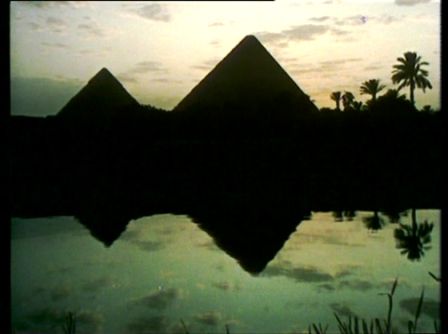
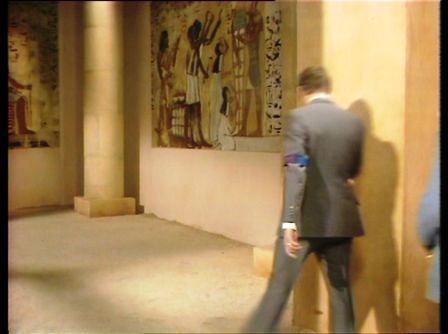
© Freemantle Media
| TP Index | *** | Wood Lane | *** | TP Locations | *** | Leith Hill | *** | Emily | *** | Teleportation | *** | Dinner Photos | *** | Kindred Spirits |
| Introduction | The Kulthan Pyramids of Peerie ... and Earth |
| The Kulthan Pyramids of Ancient Egypt | The Kulthan Pyramid in 'Revenge of Jedikiah' |
Note - this discussion is entirely based on the events on screen in the 1970s television series The Tomorrow People. It does not claim to represent the views of the writer of those serials, and provides only one possible interpretaion. Be warned of spoilers for 'Worlds Away' (and, less crucially, for 'Revenge of Jedikiah').
For a complete discussion of possible Khultan history, and a timeline, see my Khultan Empire page.
But was the Khultan damping device installed in the Great Pyramid or in another pyramid elsewhere?
| The Great Pyramids of Giza - Khultan-inspired? © Freemantle Media |
 |
 |
Inside the Khultan pyramid - A New Kingdom Tomb? © Freemantle Media |
Despite expressing interest in the Great Pyramid, it is clearly not in the great pyramid that Timus finds what he is looking for. The three great pyramids on Giza plateau are all relatively simple affairs, with no interior decoration on their limestone walls and only small and cramped chambers which are reached by narrow and steeply sloping passages (See the diagrams and images here). By contrast, the chamber which John, Timus and Elizabeth investigate is brightly lit, large and decorated by ornate wall paintings.
On the other hand, Timus comments on the geographical location of the pyramid - describing the location of the Giza Plateau.
Combining these two facts, it seems likely that, having looked over the Great Pyramid, they are visiting a smaller pyramid on the Giza site or close to it.
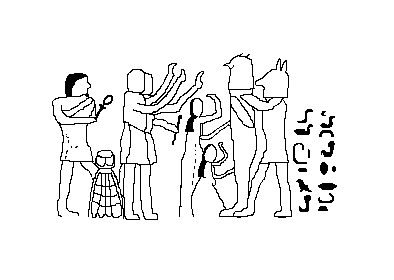 |
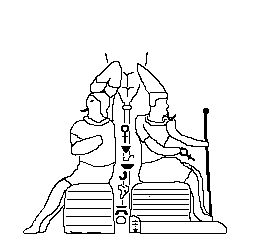 |
| The Wall decorations from the Kulthan Pyramid on Earth. Left = A, Right = B. The third, partially seen, painting was similar in style | |
As they enter the chamber, there is a large mural to their right (A), a slightly smaller one immediately in front of them (B) and a third (C, only ever partially seen) to their left, beneath which they discover an access to the Khultan equipment room. Painting A is very similar to one found in the papyrii and wall paintings which comprise the Egyptian 'Book of the Dead', and in particular to one found in the Papyrus of Hunifer (c 1370BC). The style, and the fact that the tomb walls are decorated in painted plaster, or indeed at all, points to a date late in the New Kingdom of Egypt and a pyramid associated with a late Egyptian dynasty. This would also be logical from the point of view of maintainence of the damping field equipment which would have been difficult after the Great Pyramid was sealed. It is even possible that the Great Pyramid was used as a decoy, and the equipment moved elsewhere, during periods of unrest and rebellion against the Khultan. (For further speculation, see my proposed timeline for the Khultan Empire).
Despite the increase in size (and hence intimidation and respect) over the tombs of Egypt, the Peerian pyramid has an inner chamber of identical proportions to those of the pyramid on Earth. As before, there are three wall paintings: a large mural to their right (A), a slightly smaller one immediately in front of them (B) and a third (C, only ever partially seen) to their left. Importantly, however, the paintings are very different in style to those in the pyramid on Earth.
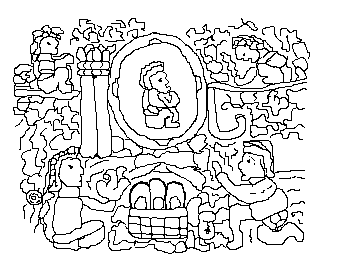 |
 |
| The Wall decorations from the Kulthan Pyramid on Earth. Left = A, Right = B. The third, partially seen, painting was again rather different in style but was suggestive of a Central American origin. | |
Painting A is very clearly South American in style and similar to Mayan glyphs implying a connection of some kind between the Khultan and the Maya. Interestingly, the Mayan culture was a builder of step pyramids, although Mayan pyramids tended to be truncated in an upper platform, and to have an external staircase.
By contrast, painting B is more difficult to classify. The three large dome shapes that dominate it may be some form of flower or ceremonial object. In profile, however, they are highly reminiscent of the tall-domed buddhist temples (or wats) of the Khmer culture of South-East Asia (primarily Cambodia and Thailand). The Khmer temples are often pyramidal in form - is it possible that this painting implies a Khultan influence on the Khmer culture?
For further speculation, see my proposed timeline for the Khultan Empire.
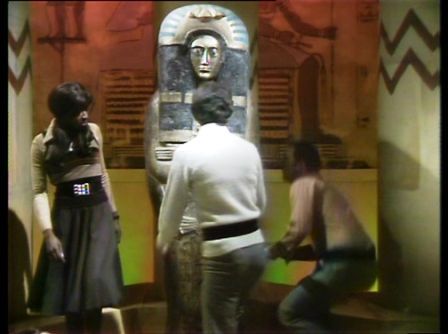 |
The pyramid from 'Revenge of Jedikiah' - note the painting behind the sarcophagus (image © Freemantle Media) |
The first of these, positioned immediately behind the focal sarcophagus, is identical to painting B in the Egyptian pyramid described above. The second is only partially seen, but appears to be in the same style. It features at least two white-kilted male Egyptians, one of whom is either carrying a leopard or (more likely) wearing a leopard skin, the tail of which hangs down around his legs. Wearing the leopard skin in ancient Egypt was a symbol of priesthood.
While it is difficult to draw conclusions from such a fragment of image, it seems likely that the painting is actually identical to painting A from above, but seen from a different viewpoint. The complete image appears to have been reproduced in the Papyrus of Hunefer.
Comments are Welcome!
For my other TP related pages click here
The 1970s television series The Tomorrow People, the Khultan and the Galactic Federation were created by Roger Price. The theory laid out above is meant as a logical extrapolation from events in the serials Worlds Away and Revenge of Jedikiah and do not represent the views of the original writer. All screenshots are property of Thames Television and Freemantle Media and are used here for comparison and clarification.
This page created by Elizabeth Stanway (April 2005). Email me here.